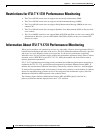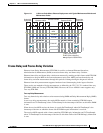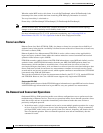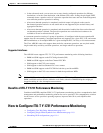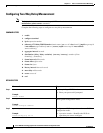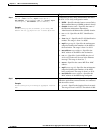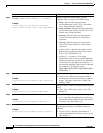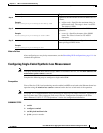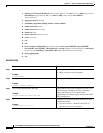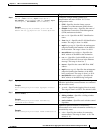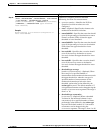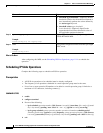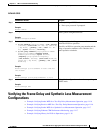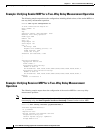
11-9
Cisco ASR 901 Series Aggregation Services Router Software Configuration Guide
OL-23826-09
Chapter 11 ITU-T Y.1731 Performance Monitoring
How to Configure ITU-T Y.1731 Performance Monitoring
What to Do Next
After configuring two-way delay measurement, see the Scheduling IP SLAs Operations, page 11-14 to
schedule the operation.
Configuring Single-Ended Synthetic Loss Measurement
Note To display information about remote (target) MEPs on destination devices, use the show ethernet cfm
maintenance-points remote command.
Complete the following steps to configure a single-ended SLM.
Prerequisites
Class of Service (CoS)-level monitoring must be enabled on MEPs associated to the Ethernet frame loss
operation using the monitor loss counter command on the devices at both ends of the operation.
Note Cisco IOS Y.1731 implementation allows monitoring of frame loss for frames on an EVC regardless of
the CoS value (any CoS or Aggregate CoS cases). See the "Configuration Examples for IP SLAs
Metro-Ethernet 3.0 (ITU-T Y.1731) Operations" section for configuration information.
SUMMARY STEPS
1. enable
2. configure terminal
3. asr901-platf-multi-nni-cfm
4. ip sla operation-number
Step 11
max-delay
milliseconds
Example:
Router(config-sla-y1731-delay)# max-delay 5000
(Optional) Sets the amount of time an MEP waits for
a frame.
• milliseconds—Specifies the maximum delay in
milliseconds (ms). The range is from 1 to 65535.
The default is 5000.
Step 12
owner
owner-id
Example:
Router(config-sla-y1731-delay)# owner admin
(Optional) Configures the owner of an IP SLAs
operation.
• owner-id—Specifies the name of the SNMP
owner. The value is from 0 to 255 ASCII
characters.
Step 13
end
Example:
Router(config-sla-y1731-delay)# end
Exits IP SLA Y.1731 delay configuration mode and
enters privileged EXEC mode.
Command Purpose




